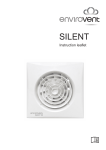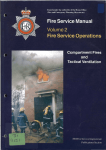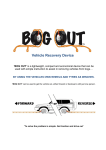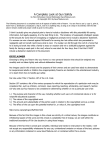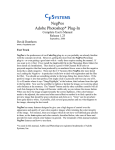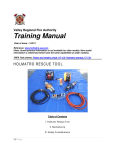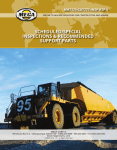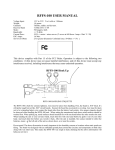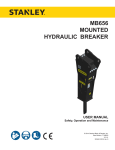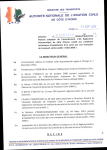Download Working in Smoke - International Fire Training Centre
Transcript
Issue 1 Jan 03 INTERNATIONAL FIRE TRAINING CENTRE FIREFIGHTER INITIAL WORKING IN SMOKE Throughout this note he means he/she and his means his/hers. Areas considered to be of prime importance are in bold type INTRODUCTION This training note is intended to provide an introduction to students on the subject of working in smoke as relevant to the Rescue and Fire Fighting Services (RFFS) employed at airports. This training note should be read in conjunction with other training notes covering operational matters, such as Internal Fires and Technical Bulletin 1/1997 “Breathing Apparatus Command and Control Procedures”. AIM To ensure that all students understand fully the basic methods of working in smoke. OBJECTIVES At the end of the instructional session dealing with this subject and after detailed study of this note and associated notes covering the subject, students will be able to: • • • • Define the correct method for working and moving in smoke Define terms associated with Ventilation Define the value of Ventilation Describe the Tactical Ventilation Techniques CONTENTS • • • • • • • • • • • • • Introduction Definition of Backdraught Sings and Symptoms of Backdraught Firefighters Actions Definition of Flashover Sings and Symptoms of Flashover Firefighter Actions Working and Moving in Smoke Searching for a fire Terms Associated with Ventilation Value of Ventilation Tactical Ventilation Techniques Summary Issue 1 Jan 03 INTRODUCTION Smoke is generally a mixture of fine solid particles, droplets of water and other liquids, and products given off by the materials involved in the fire. This is also known to us as vapour, as it is the vapour of a heated substance that burns. It is important that BA wearers are aware that vapour/gas commonly called smoke could be ignited causing a flash fire and/or sustained combustion of the vapour/gas. The fire will heat the air surrounding it and since hot air is lighter than cold, it will tend to rise very rapidly and with great force. The smoke will be carried with it. As smoke cools so its density increases and heavier particles tend to sink again. Smoke and hot gases will rise vertically until they strike a roof or ceiling then they will spread sideways. This is called mushrooming. With limited height this effect quickly takes place. Venting must be carried out at the earliest time to alleviate the risk of flashover (ie smoke explosion). When considering ventilation the possibility of backdraught should be borne in mind. Mushrooming is the high level spread of hot gases and smoke. This can be checked by early ventilation thus preventing the pre-heating of other areas by convection. The volume of smoke is no indication of the size of fire. Small fires can produce smoke for long periods and can completely smokelog the structure, making firefighting operations very difficult indeed. The type and colour of smoke can sometimes give an indication as to the material involved in the fire, ie rubber and plastics give off large volumes of thick black smoke. THE DEFINITIONS OF BACKDRAUGHT Limited ventilation can lead to a fire in a compartment producing fire gases containing significant proportions of partial combustion products and unburnt pyrolysis products. If these accumulate then the admission of air when an opening is made to the compartment can lead to a sudden deflagration. This deflagration moving through the compartment and out of the opening is a backdraught. SIGNS AND SYMPTOMS OF A BACKDRAUGHT The first clue to the possibility of a backdraught is the history of the fire: if the fire has been burning for some time, has generated lots of smoke which is now leaking out from the building, and has apparently died down without major areas of flame being visible from outside, the possibility is that it has died down from oxygen starvation. When the building is viewed from outside, it is likely that the windows of the compartment concerned will be blackened with no obvious flames within. If part of a window is broken, it is possible that this will not provide sufficient oxygen to feed the fire. In this case it is likely that smoke will be pulsing out of the hole. Fresh air is drawn in as the fire cools slightly and the hot gases contract. The expansion of the hot gases in turn drives some smoke out of the compartment. This cycle repeats itself at a frequency which depends on the size of the hole and the location of the fire relative to it. If there is a gap under the compartment door, there may be smoke pulsing there due to the mini-backdraught effect already described. There may be a whistling noise if air is being drawn into the compartment through very small gaps around the door, but this could be difficult to hear. The door may be hot on the outside. In particular, the door handle may be hot if there is a metal rod linking it to the door handle on the other side. Issue 1 Jan 03 If the compartment has been left long enough for it to cool down, air will no longer be drawn in, and the smoke pulsing effect will not be evident. However, if the compartment has not been ventilated and there are still flammable gases present, a backdraught is still possible. If the decision is taken to open the door, there may be an in-rush of air as soon as the door is ajar showing either that there is a shortage of oxygen in the compartment, or that the compartment has been much hotter and is starting to cool. Small flames may appear where the gases from the room are meeting the relatively fresh air outside, indicating that there are flammable gases in the room which are sufficiently hot to ignite given a source of fresh air, even without any other source of ignition. In either case, it may still be possible to close the door before sufficient air has entered the compartment to trigger any possible backdraught. ACTIONS BY FIREFIGHTER Once the door has been opened on to a compartment with an oxygen starved fire and fresh air has been allowed in, there is little which can be done to prevent a backdraught happening. It is far better to make appropriate decisions before the door is ever opened. When firefighter are faced with a closed door, and do not know what is behind it, they should check for any signs and symptoms described above before opening it, covering the door with a charged branch, should they decide to open it. If there is a build up of smoke outside the compartment, the possibility of backdraught appears likely. This may not prevent the backdraught but may direct its force away from the firefighters. If firefighters believe that opening a compartment door may lead to a backdraught, opening that door must be as a result of a deliberate decision. As long as the compartment door is closed, firefighters have time to think about their actions. Once the door is open, they will only have time to react to events as they occur. Whilst the decision about the timing of opening the door can only rest with the firefighters who form the firefighting crew at the scene, the consequences of that decision ultimately lie with the Officer-in-Charge of the incident. However, the compartment will still have to be inspected at some stage. The priority is then to make it safe for the firefighters to enter. As already described, a backdraught can only occur when fresh air is permitted into the compartment. It is possible for firefighters to operate in a flammable atmosphere provided there is no opportunity for things to change and for fresh air to enter whilst the firefighters are inside. It is difficult to be sure - a window might shatter, someone might unwittingly open another door to the compartment. The far safer solution is to remove the flammable gases from the compartment – ventilation. It is important to recognise that ventilation requires that fresh air should be let into the compartment. Thus, there is the possibility that a backdraught may occur during ventilation, so appropriate precautions should be taken. DEFINITION OF A FLASHOVER In a compartment fire there can come a stage where the total thermal radiation from the fire plume, hot gases and hot compartment boundaries causes the generation of flammable products of pyrolysis from all exposed combustible surfaces within the compartment. Given a source of ignition, this will result in the sudden and sustained transition of a growing fire to a fully developed fire. This is called a Flashover. It can be seen that, according to this definition, a backdraught can be a special case of a flashover. If the backdraught results in a sustained fully developed fire, a flashover Issue 1 Jan 03 has occurred. Nevertheless, it is important to be able to draw a distinction between the two because the implications for firefighters are very different. SIGNS AND SYMPTOMS OF A FLASHOVER The primary requirement for a flashover to occur is that there should be significant thermal radiation from above. This will be felt by the firefighters as a rapid increase in the temperature in the compartment, and in the heat from the hot gases at ceiling level, forcing them down low. If they can see above them, they will be able to see tongues of flame running through the gas layer. In addition, other combustible materials within the compartment will be giving off visible smoke, and flammable gases. ACTIONS BY FIREFIGHTERS As the main reason for a flashover is radiation from the hot gases and flames above them, the logical solution is to cool this area. This will have the effect of reducing the flames and radiated heat, and causing the smoke layer to lift. Directing a spray at the ceiling will have this effect. However, too much water will cause the generation of large amounts of steam. Too much cooling will bring the smoke layer down, obscuring everything. In these circumstances, it will be most effective for the firefighter to attack the hot gases with pulses of spray, observing their effect, and so judging when sufficient water has been applied. Once the immediate danger of a flashover has been eliminated, the next steps depend on whether flashover conditions could re-develop before the fire can be extinguished. If this is likely, it is important to ventilate the fire as soon as possible. If the hot gases are released faster that they are generated, the smoke layer will reduce, and the risk of flashover will reduce. Built-in roof vents are designed to do exactly this, either automatically, or when operated by the fire service. However, it is important that the correct vents are opened. The further from the fire that the vent is, the further the hot gases have to travel, and the more the chance of fire spread. Where there are no built-in vents, firefighters have the option of making their own. It must be remembered, however, that incorrect use of ventilation can result in increased fire-spread at high level as hot gases are channelled into areas they might otherwise have taken longer to reach. WORKING AND MOVING IN SMOKE At any fire situation in an enclosed area the interior may rapidly fill up with smoke and other products of combustion. For all fire situations breathing apparatus should be worn. This means that a quick entry into this environment is imperative. It must of course be done safely observing all safety/operational procedures with regards to breathing apparatus, charged lines, venting, etc.. Always use vision before applying media as visibility is impaired for a while after application of water to a fire. Keep personnel to a minimum and avoid congestion if possible. Keep entry and exits clear. Always be aware of a flashover and the possibility that the floor may have collapsed. Issue 1 Jan 03 Good pump operations and a continuous adequate water supply are essential. Remember to shuffle keeping the weight on the back foot using the correct search procedure, hands must be used in the prescribed manner. It is usually safer to keep as low as possible. Communications between BA teams and control is important. Make a mental note of the route you are taking, places and things you pass. BA wearers should keep to one side and avoid crossing over. Listen for sounds. Use your eyes. Feel the heat change. Touch. All will give an indication of where you are and where the fire can be located. Use hose lines to find your way back. If already laid out use them to get to the area of firefighting operations. Remember female coupling to the fire. Watch out for mirrors and windows, these can sometimes reflect fire. WORKING CONDITIONS Problems with vision will always be encountered in an aircraft on fire but in the area close to the seat of the fire visibility may improve owing to the oxygen supply present. Conditions are usually better but on the application of media this will change dramatically. The first water applied will immediately turn to steam. Smoke and hot gases will rise and move. When they start to cool they will drop and cause sight problems. It Is Imperative That BA Operators Keep Low With the inability to see there could be problems encountered when searching. It is imperative that the correct procedure is used. The rear of the hand must be used at all times above the head, down the front of the body and cover all areas before advance. Never use naked lights to search. Always use torch and lamps designed for use in such atmospheres, ie intrinsically safe equipment. Special equipment such as thermal image cameras are now widely available. In any situation where you have to enter an area that is smokelogged or a fire suspected, follow the correct procedures. Breathing apparatus operations/search procedures/recording and supervising must be done correctly as laid down and followed to the letter. Make full use of the senses of sight, touch and hearing. By the following of correct search and operational methods incidents can be brought to a safe conclusion in most cases. Issue 1 Jan 03 SEARCHING FOR A FIRE When searching for a fire there are a number of things that the firefighter can use to locate the seat of the fire. He can use his own senses to great effect. Sight, touch and hearing all play a major part in the discovery of a fire situation. On arrival an initial examination from the outside may well give some indication as to the internal situation: • • • • • • discoloration of paintwork (exterior) buckling of metal colour of windows smoke emission cracked windows or perspex migration of personnel All of these can be used in ascertaining the extent and area a fire may be burning in. The purpose of locating a fire quickly is of course the rapid extinguishment of the fire thus allowing egress to the structure and subsequent rescue of personnel. The two should take place simultaneously to achieve optimum results. Location of the fire is sometimes obvious but on other occasion a deep-seated fire may take some time to locate. VENTILATION Ventilation is defined as: “The removal of heated air, smoke and other airborne contaminants from a structure, and their replacement with a supply of fresher air.” In firefighting, there are a number of additional terms which are used: Self Ventilation occurs when the fire damages the structure so that increased ventilation occurs. Automatic Ventilation occurs when pre-installed vents are activated automatically, usually in the early stages of the fire, by the fire detection system or fusible link devices. Tactical Ventilation requires the intervention of the fire service to open up the building, releasing the products of combustion and allowing fresher air to enter. THE VALUE OF VENTILATION Like any other tactical option available to the firefighter, tactical ventilation can make things worse if it applied incorrectly. Properly used, it can have significant beneficial effects of firefighting: • it can assist escape by restricting the spread of smoke, improving visibility and extending available egress times; • it can aid rescue operations by reducing smoke and toxic gases, which hinder search activities and endanger trapped occupants; • it can improve the safety of firefighters by reducing the risk of flashover and backdraught, and making it easier to control the effects of backdraught; Issue 1 Jan 03 • it can speed attack and extinguishment by removing heat and smoke so that firefighters can enter a compartment earlier and, with improved visibility, make it easier for firefighters to locate and deal with the fire; • it can reduce property damage by making it possible for the fire to be located and tackled more quickly; • it can restrict fire spread by limiting the movement of smoke and hot gases TACTICAL VENTILATION TECHNIQUES All ventilation techniques depend on planning where fresh air will be allowed to enter the building/aircraft, where hot gases and smoke will be allowed to leave the building/aircraft and, is possible, the routes they will follow within the building/aircraft. There are two basic options: Vertical or Top Ventilation – making an opening at high level (usually through the roof) so that the buoyancy of the hot gases and smoke enables them to escape vertically. Horizontal or Cross Ventilation – making openings in the external walls (for example using windows and doors) so that the wind assists in the removal of hot gases and smoke. Branches must be in position in case of flashover occurring and to guard against the risk of fire spread. Subject to the necessary precautions however, it is important that ventilation begins as soon as possible. If unwisely or incorrectly performed, ventilation can lead to the rapid spread of fire within the area. It could be that the fire has burned through the roof and vented itself. Breathing apparatus crews may be venting as they work but in all cases it must be done in a safe manner with no risk of spreading the fire, or causing injury to BA teams/casualties within the aircraft. SUMMARY Working and moving in smoke is a difficult situation. The possibility of becoming disorientated in a smokelogged area must always be borne in mind and a mental note should be made of any features which will assist in retracing the route in safety. When working in these conditions always work in pairs as this not only promotes confidence but makes it possible for one person to assist the other in case of difficulty. When in strange surroundings and unable to see, the only course of action is to work by touch. In such circumstances the necessity for caution is obvious and much can be done to reduce the possibility of accident by attention to a few simple points. Ventilation will allow heat and smoke to leave an area reducing damage to the craft and serving the purpose of allowing a better chance of survival for occupants unable to escape unaided. Ref: Fire Service Manual Vol 2 Fire Service Operations Compartment Fires and Tactical Ventilation








